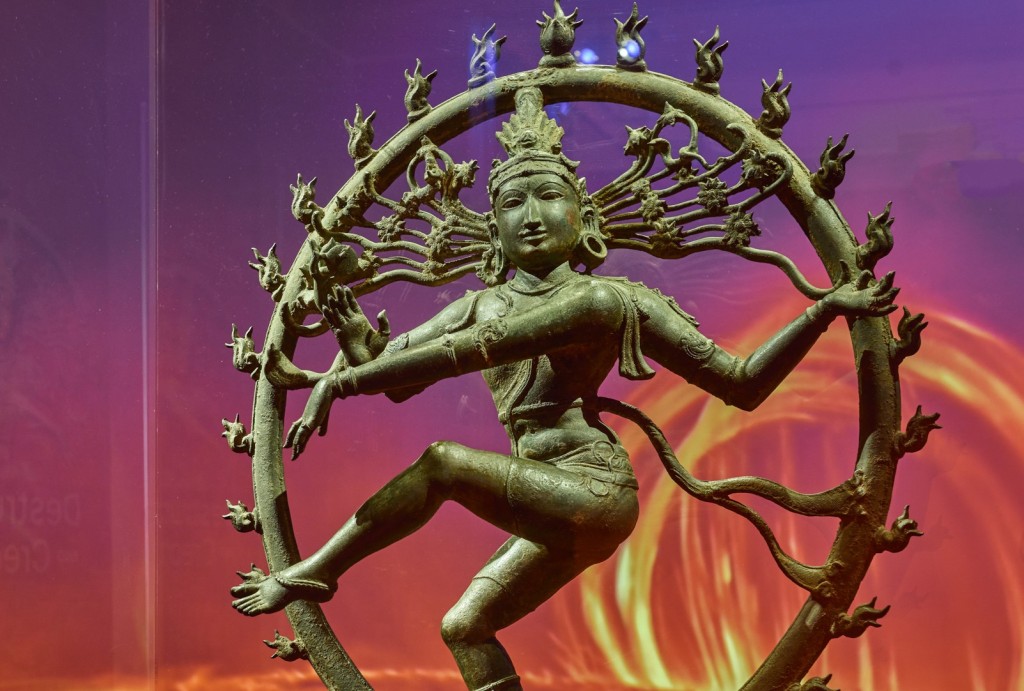
“It’s hard to think of other religious traditions worldwide where the gods dance so much,” observes Forrest McGill, co-curator of a new exhibit at the Asian Art Museum that explores the roots of South and Southeast Asian performance.
“Beyond Bollywood: 2000 Years of Dance in Art,” an expansive show filling the museum’s 8,500-square-foot pavilion, includes a wide-ranging but well-focused mix of 120 objects from five countries, borrowed from 29 museums and private collections. It’s on view through July 10.
Beyond the paintings and sculpture, there are dancers in motion at every turn –images and sounds on tablets in every gallery. It’s an astonishing way to bring centuries-old movement to contemporary life.
The exhibit pavilion, opened in 2021, also allows performance videos to fill entire gallery walls, sometimes three walls at a time.
As the show turns its focus to beyond Bollywood — the Hollywood of India — it also points out that dance, depicted by visual artists or performed on stage, is far more than entertainment and always has been.
“Beyond every graceful swish or vigorous stomp,” notes museum director Jay Xu, “the stakes are quite high: personal pleasure and public renown, birth and death, global creation and destruction, gangs of gods and goddesses setting the pulse of the universe.”
The exhibit follows a path through six themes, each with a distinctive signature artwork, then additional works expanding the scope. The museum’s always-ingenious installation means, in this case, that we can see a historical dance tradition in an ancient sculpture, then in a 19th-century painting, then in a video of a recent, contemporary performance.
It’s “immersive,” to use the current exhibit cliché, but also logically informative.
The galleries themselves are dimly lit, with artwork spotlighted and the videos, of course, brightly visible on walls or tablets. With a musical soundtrack added, and some floating fabric panels, the experience sometimes feels like a dream.
“Beyond Bollywood” was produced in conjunction with the Cincinnati Art Museum, where the exhibit opened last November, with Ainsley M. Cameron as co-curator. The dramatic “evocative spaces and immersive elements,” as they are called, originated with the Asian Art Museum curators and planers.
The opening gallery, with the theme “Destruction and Creation,” is dominated by “Shiva Nataraja, the Lord of Dance,” a dynamic copper alloy figure from the Thanjavur district of India, dating from approximately 1125-1175. It’s a vivid image with an iconic pose, but as curator McGill points out, “images of Shiva (and those of other deities) in this exhibition were created for worship and not just for aesthetic affect.”
The cross-cultural impact of these deities is on view, too. Among the artwork is the cover of a 2010 Newsweek magazine with President Barack Obama, “God of All Things,” posed like a many-armed Shiva Nataraja. The exhibit catalog even depicts a can of Shiva IPA beer from Asheville, N.C.; a brewery owner said it was meant to honor the god’s power and strength.
The “Devotion” gallery that follows is dominated by the story of Krishna, an incarnation of the Hindu god Vishnu, living in a village, going into the forest to play his flute and attracting the cowherder women who rush to join him in dance. A video gives a modern interpretation by dancers in Bangalore.
“Subjugation,” or the conquest of negative forces, is explored in a stunning variety of artwork, including an18-inch-tall bronze from Thailand, dating from 1050-1100, “Dancing Hevajra surrounded by dancing yoginis.” In the same gallery is an exquisite gold-and-topaz armlet detailing Krishna overcoming the serpent Kaliya.
The “Glorification” section includes a surprisingly vivid stone carving of dancers and musicians entertaining a deity or nobleman, from the former kingdom of Angkor and dating from 1075-1125. Filling a nearby wall, a video capturing a Royal Ballet of Cambodia performance offers a similar scene, fresh and colorful. A pair of dazzling wood figures, a dancing mythical bird-woman and bird-man, with gold leaf and inlaid glass detailing, are mirrored in a video of contemporary dancers in similar costumes.
The final “Celebration” display is replete with wedding events as well as a video filling three gallery walls, depicting performers dancing in the back streets of Singapore. It’s an intriguing closer.
The exhibit will get even more “immersive” with live pop-up dance performances in the galleries on select Thursdays and Sundays through the run. These will go beyond Bollywood too, with performers of Indian, Balinese, Cambodian and Jazz styles.
‘BEYOND BOLLYWOOD: 2000 YEARS OF DANCE IN ART’
Through: July 10
Where: Asian Art Museum, 200 Larkin St., San Francisco
Hours: 10 a.m.-8 p.m. Thursday, 10 a.m.-5 pm. Friday-Monday, closed Tuesday and Wednesday
Admission: $24-$30; 415-581-3500, www.asianart.org
𝗖𝗿𝗲𝗱𝗶𝘁𝘀, 𝗖𝗼𝗽𝘆𝗿𝗶𝗴𝗵𝘁 & 𝗖𝗼𝘂𝗿𝘁𝗲𝘀𝘆: www.mercurynews.com
𝗙𝗼𝗿 𝗮𝗻𝘆 𝗰𝗼𝗺𝗽𝗹𝗮𝗶𝗻𝘁𝘀 𝗿𝗲𝗴𝗮𝗿𝗱𝗶𝗻𝗴 𝗗𝗠𝗖𝗔,
𝗣𝗹𝗲𝗮𝘀𝗲 𝘀𝗲𝗻𝗱 𝘂𝘀 𝗮𝗻 𝗲𝗺𝗮𝗶𝗹 𝗮𝘁 dmca@enspirers.com


